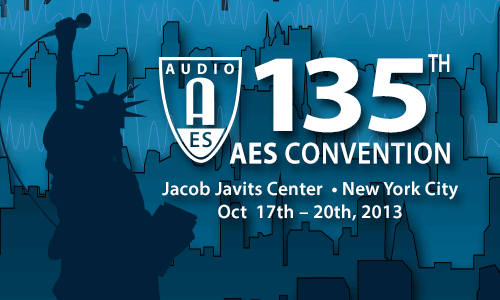
AES New York 2013
Paper Session P2
Thursday, October 17, 9:00 am — 12:00 pm (Room 1E09)
Paper Session: P2 - Signal Processing—Part 1
Chair:
Jaeyong Cho, Samsung Electronics DMC R&D Center - Suwon, Korea
P2-1 Linear Phase Implementation in Loudspeaker Systems: Measurements, Processing Methods, and Application Benefits—Rémi Vaucher, NEXO - Plailly, France
The aim of this paper is to present a new generation of EQ. It provides a way to ensure phase compatibility from 20 Hz to 20 kHz over a range of different speaker cabinets. This method is based on a mix of FIR filters and IIR filters. The use of FIR filters allows a tuning of the phase independently from magnitude and allows an acoustic linear phase above 500 Hz. All targets used to compute FIR coefficient are based upon extensive measurement and subjective listening tests. A template has been set to normalize the crossover frequencies in the low range, enabling compatibility of every sub-bass with the main cabinets.
Convention Paper 8926 (Purchase now)
P2-2 Applications of Inverse Filtering to the Optimization of Professional Loudspeaker Systems—Daniele Ponteggia, Studio Ponteggia - Terni (TR), Italy; Mario Di Cola, Audio Labs Systems - Casoli (CH), Italy
The application of FIR filter technology to implement Inverse Filtering into a Professional Loudspeakers Systems nowadays is easier and more affordable because of the latest development of DSP technology and also because of the existence of a new DSP platform dedicated to the end user. This paper presents an analysis, based on real world examples, of a possible methodology that can be used in order to synthesize an appropriate Inverse Filter both to process a single driver, from a Time Domain perspective in a multi-way system, and to process the output pass-band from of a multi-way system for phase linearization. The analysis and discussion of results for some applications will be shown through real world test and measurements.
Convention Paper 8927 (Purchase now)
P2-3 Live Event Performer Tracking for Digital Console Automation Using Industry-Standard Wireless Microphone Systems—Adam J. Hill, University of Derby - Derby, Derbyshire, UK; Kristian "Kit" Lane, University of Derby - Derby, UK; Adam P. Rosenthal, Gand Concert Sound - Elk Grove Village, IL, USA; Gary Gand, Gand Concert Sound - Elk Grove Village, IL, USA
The ever-increasing popularity of digital consoles for audio and lighting at live events provides a greatly expanded set of possibilities regarding automation. This research works toward a solution for performer tracking using wireless microphone signals that operates within the existing infrastructure at professional events. Principles of navigation technology such as received signal strength (RSS), time difference of arrival (TDOA), angle of arrival (AOA), and frequency difference of arrival (FDOA) are investigated to determine their suitability and practicality for use in such applications. Analysis of potential systems indicates that performer tracking is feasible over the width and depth of a stage using only two antennas with a suitable configuration, but limitations of current technology restrict the practicality of such a system.
Convention Paper 8928 (Purchase now)
P2-4 Real-Time Simulation of a Family of Fractional-Order Low-Pass Filters—Thomas Hélie, IRCAM-CNRS UMR 9912-UPMC - Paris, France
This paper presents a family of low-pass filters, the attenuation of which can be continuously adjusted from 0 decibel per octave (filter is a unit gain) to -6 decibels per octave (standard one-pole filter). This continuum is produced through a filter of fractional-order between 0 (unit gain) and 1 (one-pole filter). Such a filter proves to be a (continuous) infinite combination of one-pole filters. Efficient approximations are proposed from which simulations in the time-domain are built.
Convention Paper 8929 (Purchase now)
P2-5 A Computationally Efficient Behavioral Model of the Nonlinear Devices—Jaeyong Cho, Samsung Electronics DMC R&D Center - Suwon, Korea; Hanki Kim, Samsung Electronics DMC R&D Center - Suwon, Korea; Seungkwan Yu, Samsung Electronics DMC R&D Center - Suwon, Korea; Haekwang Park, Samsung Electronics DMC R&D Center - Suwon, Korea; Youngoo Yang, Sungkyunkwan University - Suwon, Korea
This paper presents a new computationally efficient behavioral model to reproduce the output signal of the nonlinear devices for the real-time systems. The proposed model is designed using the memory gain structure and verified for its accuracy and computational complexity compared to other nonlinear models. The model parameters are extracted from a vacuum tube amplifier, Heathkit’s W-5M, using the exponentially-swept sinusoidal signal. The experimental results show that the proposed model has 27% of the computational load against the generalized Hammerstein model and maintains similar modeling accuracy.
Convention Paper 8930 (Purchase now)
P2-6 High-Precision Score-Based Audio Indexing Using Hierarchical Dynamic Time Warping—Xiang Zhou, Bose Corporation - Framingham, MA, USA; Fangyu Ke, University of Rochester - Rochester, NY, USA; Cheng Shu, University of Rochester - Rochester, NY, USA; Gang Ren, University of Rochester - Rochester, NY, USA; Mark F. Bocko, University of Rochester - Rochester, NY, USA
We propose a novel audio signal processing algorithm of high-precision score-based audio indexing that accurately maps a music score with its corresponding audio. Specifically we improve the time precision of existing score-audio alignment algorithms to find the accurate positions of audio onsets and offsets. We achieve higher time precision by (1) improving the resolution of alignment sequences, and (2) admitting a hierarchy of spectrographic analysis results as audio alignment features. The performance of our proposed algorithm is testified by comparing the segmentation results with manually composed reference datasets. Our proposed algorithm achieves robust alignment results and enhanced segmentation accuracy and thus is suitable for audio engineering applications such as automatic music production and human-media interactions.
Convention Paper 8931 (Purchase now)
